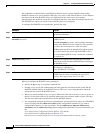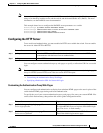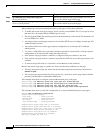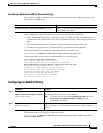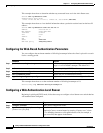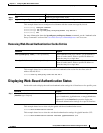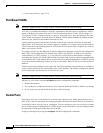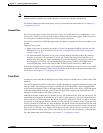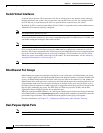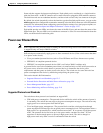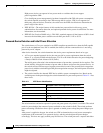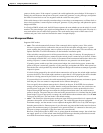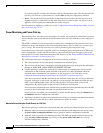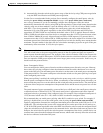
12-2
Catalyst 2960 and 2960-S Switch Software Configuration Guide
OL-8603-09
Chapter 12 Configuring Interface Characteristics
Understanding Interface Types
• Connecting Interfaces, page 12-10
Port-Based VLANs
Note Stacking is supported only on Catalyst 2960-S switches running the LAN base image.
A VLAN is a switched network that is logically segmented by function, team, or application, without
regard to the physical location of the users. For more information about VLANs, see the Chapter 13,
“Configuring VLANs.” Packets received on a port are forwarded only to ports that belong to the same
VLAN as the receiving port. Network devices in different VLANs cannot communicate with one another
without a Layer 3 device to route traffic between the VLANs.
VLAN partitions provide hard firewalls for traffic in the VLAN, and each VLAN has its own MAC
address table. A VLAN comes into existence when you configure a local port to be associated with the
VLAN, when the VLAN Trunking Protocol (VTP) learns of its existence from a neighbor on a trunk, or
when a user creates a VLAN.
To configure VLANs, use the vlan vlan-id global configuration command to enter VLAN configuration
mode. The VLAN configurations for normal-range VLANs (VLAN IDs 1 to 1005) are saved in the
VLAN database. If VTP is version 1 or 2, you must first set VTP mode to transparent to configure
extended-range VLANs (VLAN IDs 1006 to 4094). Extended-range VLANs created in transparent mode
are not added to the VLAN database but are saved in the switch running configuration. With VTP version
3, you can create extended-range VLANs in client or server mode. These VLANs are saved in the VLAN
database.
VLANs can be formed with ports across the stack. The VLAN database is downloaded to all switches in
a stack, and all switches in the stack build the same VLAN database. The running configuration and the
saved configuration are the same for all switches in a stack.
Note Stacking is supported only on Catalyst 2960-S switches running the LAN base image.
Add ports to a VLAN by using the switchport interface configuration commands:
• Identify the interface.
• For a trunk port, set trunk characteristics, and, if desired, define the VLANs to which it can belong.
• For an access port, set and define the VLAN to which it belongs.
Switch Ports
Switch ports are Layer 2-only interfaces associated with a physical port. Switch ports belong to one or
more VLANs. You use switch ports for managing the physical interface and associated Layer 2 protocols.
A switch port can be an access port or a trunk port. You can configure a port as an access port or trunk
port or let the Dynamic Trunking Protocol (DTP) operate on a per-port basis to set the switchport mode
by negotiating with the port on the other end of the link.
Configure switch ports by using the switchport interface configuration commands.



